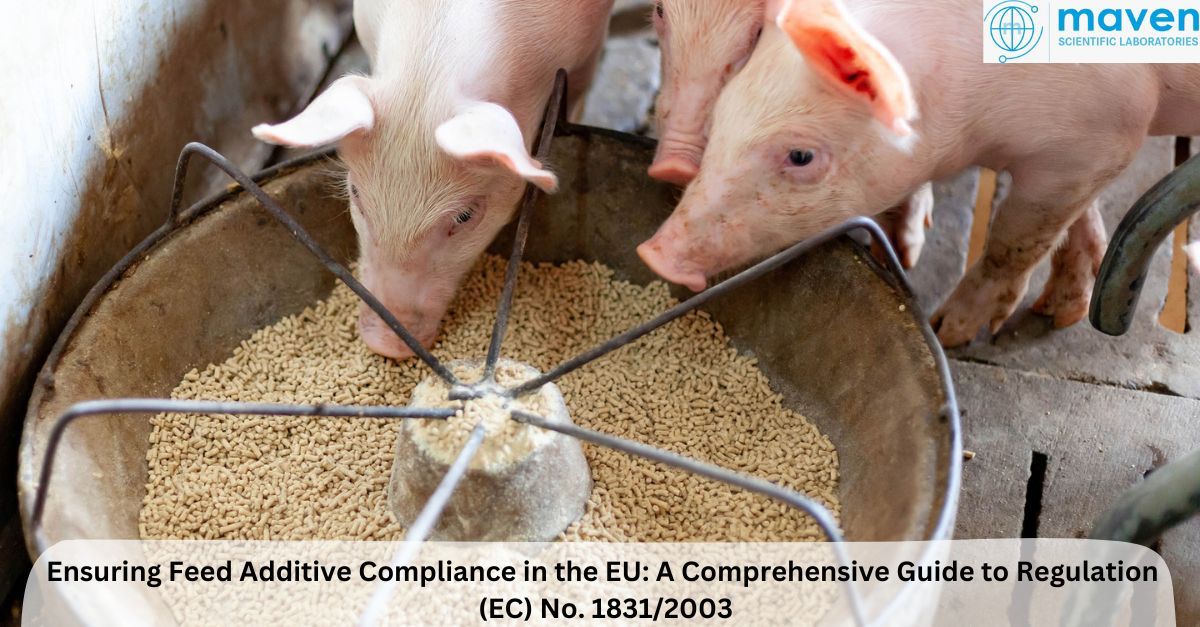Ensuring Feed Additive Compliance in the EU: A Comprehensive Guide to Regulation (EC) No. 1831/2003
November 26, 2024
Feed additives are integral to modern animal husbandry, playing a pivotal role in enhancing nutrition, boosting productivity, and ensuring the overall safety of food derived from animals. However, their use within the European Union (EU) is strictly regulated to safeguard animal health, human health, and environmental integrity.
Regulation (EC) No. 1831/2003, adopted in September 2003, outlines the comprehensive framework governing the approval, use, and marketing of feed additives in the EU. This blog explores the intricate details of regulation, the critical role of the European Food Safety Authority (EFSA), and how regulatory expertise can simplify compliance for businesses.
What is Regulation (EC) No. 1831/2003?
This regulation establishes a harmonized framework for feed additive approval and use across the EU. It ensures that all additives placed on the market meet stringent safety, efficacy, and transparency standards.
Key Objectives of the Regulation
- Protecting Health:
- Ensures that feed additives are safe for animals, humans (through the food chain), and the environment.
- Supporting Efficacy:
- Verifies that additives perform their intended function without causing unintended harm.
- Promoting Transparency:
- Requires clear labelling, proper documentation, and traceability throughout the supply chain.
Core Requirements of Regulation (EC) No. 1831/2003
1. Pre-Market Authorization
Before marketing a feed additive in the EU, approval must be obtained through a rigorous evaluation process overseen by EFSA.
- Application Dossier:
- Must include toxicological studies, safety assessments, efficacy data, and environmental impact analyses.
- Justifies the additive’s classification and its intended use.
2. Classification of Feed Additives
Feed additives are categorized into specific functional groups, including:
- Technological Additives: Improve the manufacturing or storage of feed (e.g., preservatives, emulsifiers, antioxidants).
- Sensory Additives: Enhance feed palatability (e.g., flavorings, colorants).
- Nutritional Additives: Provide essential nutrients like vitamins, minerals, and amino acids.
- Zootechnical Additives: Improve animal performance or health (e.g., digestibility enhancers, gut flora stabilizers).
- Coccidiostats and Histomonostats: Used to prevent diseases like coccidiosis in poultry.
3. Labelling Requirements
Feed additives must be accurately labelled to ensure proper usage and traceability. Mandatory details include:
- Product name and functional group.
- Identification number.
- Instructions for use, including dosages and species-specific applications.
- Warnings and precautions, if applicable.
4. Undesirable Substances
To protect animal and human health, the regulation imposes limits on contaminants like:
- Heavy Metals: Lead, cadmium, and mercury.
- Mycotoxins: Aflatoxins, fumonisins, and ochratoxins.
- Dioxins and PCBs: Persistent environmental pollutants.
5. Genetically Modified Organisms (GMOs)
If feed additives involve GMOs, they must comply with additional EU regulations governing their safety, labelling, and traceability.
The Role of EFSA in Feed Additive Approval
The European Food Safety Authority (EFSA) is central to the feed additive approval process. It conducts independent scientific evaluations and provides recommendations to the European Commission.
EFSA’s Assessment Criteria
- Safety:
- Evaluates the impact of additives on target species, consumers, and the environment.
- Efficacy:
- Assesses whether the additive performs as claimed without adverse side effects.
- Quality:
- Verifies compliance with good manufacturing practices (GMPs) and analytical methods.
Once EFSA issues a scientific opinion, the European Commission decides whether to grant market authorization.
Compliance Challenges in the EU Feed Additive Market
1. Complex Application Processes
- Preparing a feed additive dossier for EFSA is data-intensive and requires detailed information on toxicology, safety, efficacy, and environmental impact.
- Companies must validate their methodologies to ensure consistency and reproducibility.
2. Evolving Regulatory Landscape
- Regular updates to permissible limits for contaminants and new GMO requirements necessitate ongoing vigilance.
3. Ensuring Traceability
- Accurate labelling and record-keeping are critical for meeting traceability and transparency standards.
Regulatory Compliance Services for Feed Additives
Navigating the complexities of Regulation (EC) No. 1831/2003 requires expertise in EU regulations and technical dossier preparation. Regulatory compliance services provide tailored support to businesses, ensuring smooth market entry and adherence to all legal requirements.
Key Services
- Ingredient Classification:
- Determination of whether substances qualify as feed materials, additives, or veterinary drugs.
- Feed Material Notifications:
- Assistance with notifying EU authorities for first-time market entries.
- Guidance on Contaminants:
- Expertise in complying with limits on heavy metals, dioxins, and mycotoxins.
- Dossier Preparation:
- Comprehensive submission management, including safety, efficacy, and environmental impact studies.
- Analytical Method Validation:
- Submission of validated analytical methods to the European Union Reference Laboratory (EURL).
- Post-Market Support:
- Monitoring regulatory updates and ensuring continued compliance.
Conclusion
Regulation (EC) No. 1831/2003 underscores the EU's commitment to animal welfare, food safety, and environmental protection. Although the regulatory framework is stringent, businesses can successfully navigate these requirements with the right expertise and guidance.
At Maven, we specialize in regulatory compliance for feed additives, offering end-to-end services to support your market entry and ensure long-term compliance. From dossier preparation to EFSA submissions and post-market monitoring, our experts simplify the complexities of EU regulations.
Contact Maven today to ensure your feed additives meet the rigorous standards of Regulation (EC) No. 1831/2003 and achieve your business objectives with confidence!


Post a comment